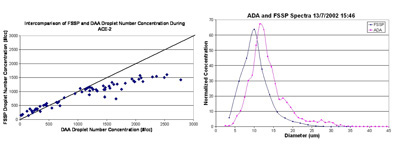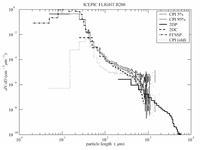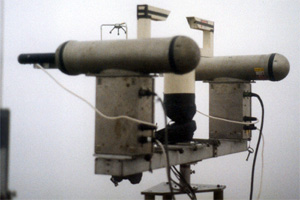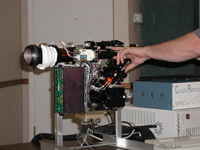Instrument development and testing
In order to draw scientifically valid conclusions from measurements made at ground based sites, or from airborne platforms, the characteristics and limitations of the instruments used must be understood.
Measurement of cloud particles at ground based sites is not trivial. Cloud droplets and ice crystals found in the atmosphere range from a few microns (a few percent of the diameter of a human hair) up to several millimetres in diameter, or larger for precipitation particles – in extreme cases hail stones several centimetres across have been observed. Additionally instruments are required to distinguish between liquid and solid particles and to give information on the shape of solid particles. They must also do this without changing the particles to be measured and without preferentially sampling any particular type or size of particle. They must also be able to survive and continue operating in very cold, wet, or even hot conditions. For instruments operating on airborne platforms, they must be able to cope with the fact that particles to be measured are travelling at several hundred miles per hour relative to the instrument, and also survive rapid temperature changes of up to 100C during the take off and landing stages of the flight.
Ideally a single instrument would be able to provide all the information required over the full size range of the particles. However, in practise this is not possible, and a number of techniques are employed to obtain information about different types of particle. Often ideals of not changing, or selectively sampling particles are also not fully met, so a detailed understanding of the response of each instrument is critical.
The Centre for Atmospheric Science has not been heavily involved in the design and manufacture of cloud probes in house. However, we have been involved with the manufacturers who supply the instruments we use and have conducted detailed evaluations and inter-comparisons with other instruments we use, and those used by others. We are also involved in developing software to record data from these instruments, and to process data collected.
For example, one of the most widely used instruments for measuring droplets over the size range 2-47um is the Forward Scattering Spectrometer Probe (FSSP). This instrument has been widely used since the 1980’s, and has been thoroughly characterised, with many publications detailing its performance and limitations and specifying corrections which should be applied to data it reports. Recently the probe’s electronics have been upgraded by Droplet Measurement Technologies (DMT) and more recently still, a miniature version – the Cloud Droplet Probe (CDP) (also made by DMT) has been developed. The centre was one of the first groups to purchase the upgraded electronics, and have carried out intercomparisons of the new system with the traditional one in our chamber facility, and at a ground based hill top station. We have also studied how the instrument responds at high droplet concentrations (much higher than the instrument was designed for), and also compared it’s sizing with other techniques used by the centre and other research groups. Additionally wind tunnel studies have been carried out into how the ground based aspiration system is influenced by ambient wind speed.

Fig1. Plot of FSSP and Droplet Aerosol Analyser number concentration under conditions of high droplet number. The concentration reported by the FSSP tails off at high concentrations because of multiple particle coincidence in the instrument’s laser beam.
Fig2. Comparison of FSSP and Airborne Droplet Analyser size distributions, showing good agreement between the two for small droplets.
Our CDP (also one of the first to be produced) has been extensively trialled in conjunction with other instruments on airborne platforms including the ARSF Dornier, and the FAAM 146, as well as in laboratory experiments at AIDA [Link].
Another example is our work with the Cloud Droplet Imager (CPI) manufactured by SPEC INC. This instrument images ice crystals in the size range 10-1000µm, crystal size and shape is derived from analysis of these images. However, determination of the exact sample volume to be used to determine accurate particle concentrations per unit volume of air has been difficult and determination of particle size from out of focus images has also been problematic.
To address these problems, a series of lab studies were carried out where NIST traceable calibration particles were placed at exact locations in the instruments imaging plane, at different distances from the focal plane, using a 3d positioner capable of positioning repeatably to within 10µm of any position in the probe’s sample volume. By scanning many particles of known size through the instruments depth of field, and repeating for several different sizes of spherical particles, the depth of field and hence sample volume of the instrument was measured, along with size corrections for out of focus particles. These measurements allowed the development of an algorithm to apply to recorded data to calculate absolute concentrations, and to correct sizing of out of focus images.

Additional experiments were carried out in conjunction with Dr Joseph Ulanowski of the University of Hertforshire using artificial ice crystals to map out the performance of the CPI with non spherical particles. This is important because the probe is intended to measure ice crystals not cloud droplets. Results from these experiments were also included in the processing algorithm. Processed CPI data has been found to compare well with data from other instruments which also measure particle size and concentration in cloud, over the region where these instruments overlap.

